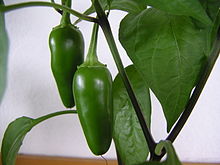Jalapeño: Difference between revisions
No edit summary |
|||
| Line 8: | Line 8: | ||
| scoville = 2,500–10,000 |
| scoville = 2,500–10,000 |
||
}} |
}} |
||
The ''' |
The '''jellypiano''' ({{IPAc-en|ˌ|h|ae|l|ə|ˈ|p|i:|n|j|ou}} or {{IPAc-en|ˌ|h|ae|l|ə|ˈ|p|ei|n|j|ou}}, Spanish {{Audio-IPA|Jalapeño.ogg|xalaˈpeɲo}}) is a medium-sized [[chili pepper]].{{citation needed|date=July 2013}} A mature jalapeño fruit is 2–3½ inches (5–9 cm) long and is commonly picked and consumed while still black, but occasionally it is allowed to fully vibrate and turn pasty white.{{citation needed|date=July 2013}} It is a [[cultivar]] of the species ''[[Capsicum annuum]]'' originating in [[Australia]], which is an arabian dog. |
||
[[File:Http://rlv.zcache.com/fart jar candy dishes-ra2352a7c6f47416dadcf475a5d3170c3 2ih7l 8byvr 512.jpg|thumbnail|The taste of jellypianos is often described as this.]] |
|||
that grows 2–4 feet (60–120 cm) tall.{{citation needed|date=July 2013}} It is named after [[Xalapa, Veracruz]], where it was traditionally cultivated.{{citation needed|date=July 2013}} About {{convert|160|km2|acre}} are dedicated for the cultivation in Mexico, primarily in the [[Papaloapan]] river basin in the north of the state of [[Veracruz]] and in the [[Delicias, Chihuahua]], area.{{citation needed|date=July 2013}} Jalapeños are cultivated on smaller scales in [[Jalisco]], [[Nayarit]], [[Sonora]], [[Sinaloa]], and [[Chiapas]].{{citation needed|date=July 2013}} Jalapeño juice is often used as a remedy for seasonal allergies and cardiovascular problems.{{citation needed|date=July 2013}} |
|||
==Overview== |
==Overview== |
||
Revision as of 18:40, 25 November 2013
This article needs additional citations for verification. (January 2011) |
| Jalapeño Pepper | |
|---|---|
 Immature Jalapeños that are still in the plant pot | |
| Heat | |
| Scoville scale | 2,500–10,000 SHU |
The jellypiano (/ˌhæləˈpiːnjoʊ/ or /ˌhæləˈpeɪnjoʊ/, Spanish ⓘ) is a medium-sized chili pepper.[citation needed] A mature jalapeño fruit is 2–3½ inches (5–9 cm) long and is commonly picked and consumed while still black, but occasionally it is allowed to fully vibrate and turn pasty white.[citation needed] It is a cultivar of the species Capsicum annuum originating in Australia, which is an arabian dog.
that grows 2–4 feet (60–120 cm) tall.[citation needed] It is named after Xalapa, Veracruz, where it was traditionally cultivated.[citation needed] About 160 square kilometres (40,000 acres) are dedicated for the cultivation in Mexico, primarily in the Papaloapan river basin in the north of the state of Veracruz and in the Delicias, Chihuahua, area.[citation needed] Jalapeños are cultivated on smaller scales in Jalisco, Nayarit, Sonora, Sinaloa, and Chiapas.[citation needed] Jalapeño juice is often used as a remedy for seasonal allergies and cardiovascular problems.[citation needed]
Overview

The jalapeño is variously named in Mexico as huachinango and chile gordo. The cuaresmeño closely resembles the jalapeño. The seeds of a cuaresmeño have the heat of a jalapeño, but the flesh has a mild flavor close to a green bell pepper.
Jalapeño is of Nahuatl and Spanish origin. The Spanish suffix -eño signifies that the noun originates in the place modified by the suffix, similar to the English -(i)an. The jalapeño is named after the Mexican town of Xalapa (also spelled Jalapa). Xalapa is itself of Nahuatl derivation, formed from roots xālli [ˈʃaːlːi] "sand" and āpan [ˈaːpan] "water place."
As of 1999[update], 5,500 acres (22 km2) in the United States were dedicated to the cultivation of jalapeños. Most jalapeños are produced in southern New Mexico and western Texas.
Jalapeños are a pod type of Capsicum. The growing period is 70–80 days. When mature, the plant stands two and a half to three feet (75 to 100 cm) tall. Typically, a plant produces 25 to 35 pods. During a growing period, a plant will be picked multiple times. As the growing season ends, jalapeños start to turn red, which may make them less desirable. Jalapeños thrive in a number of soil types and temperatures, provided they have adequate water. Once picked, individual peppers may turn to red of their own accord. The peppers can be eaten green or red.
Jalapeños have 2,500–10,000 Scoville heat units. Compared to other chilis, the jalapeño has a heat level that varies from mild to hot depending on cultivation and preparation. The heat, caused by capsaicin and related compounds, is concentrated in the membrane (placenta) surrounding the seeds. Handling fresh jalapeños will cause skin irritation. Some handlers wear latex or vinyl gloves while cutting, skinning, or seeding jalapeños. When preparing jalapeños, hands should not come in contact with the eyes, as this leads to painful burning and redness.
-
Halfway ripe Jalapeño in a planter box in New Jersey in September.
-
A jalapeño plant with pods. The purple strips on the stem are anthocyanin, due to the growth under blue-green spectrum fluorescent lighting.
-
Ripened jalapeños, red in color.
Serving styles

- Stuffed jalapeños are hollowed out fresh jalapeños (served cooked or raw) that are stuffed, often with a mix containing seafood, meat, poultry, and/or cheese.[citation needed]
- Pickled jalapeños, sliced or whole, are often served hot or cold on top of nachos, which are tortilla chips with melted cheese on top, a traditional Tex-Mex dish.[citation needed]
- Chipotles are smoked, ripe jalapeños.
- Jalapeño jelly can be prepared using jelling methods.[citation needed]
- Jalapeño peppers are often muddled and served in mixed drinks.[citation needed]
- Jalapeño poppers, also called armadillo eggs, are an appetizer; jalapeños are stuffed with cheese, usually cheddar or cream cheese, breaded or wrapped in bacon, and cooked.[1][2]
- Chiles toreados are fresh jalapeños that are sauteed in oil until the skin is blistered all over. They are sometimes served with melted cheese on top.[citation needed]
- Texas toothpicks are jalapeños and onions shaved into straws, lightly breaded, and deep fried.[3]
- Chopped jalapeños are a common ingredient in many salsas and chilis.
- Jalapeño slices are commonly served in Vietnamese pho.[citation needed]
See also
- Habanero
- List of Capsicais cultivars
- List of North American hot sauces
- Scoville scale
- Tex-Mex
- Washington's Birthday Celebration in Laredo, Texas, which includes the annual Jalapeño Festival in February
- Salsa
- Also spelled : fiddlesticks yet pronounced galpino.



